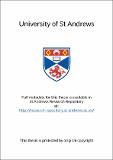Files in this item
Syntheses and properties of liquid crystalline macrocyclic complexes
Item metadata
| dc.contributor.advisor | Crayston, Joe A. | en |
| dc.contributor.author | McGregor, Alan | en |
| dc.coverage.spatial | 171p | en |
| dc.date.accessioned | 2021-04-08T08:56:58Z | |
| dc.date.available | 2021-04-08T08:56:58Z | |
| dc.date.issued | 1997 | |
| dc.identifier.uri | https://hdl.handle.net/10023/21812 | |
| dc.description.abstract | Investigations are conducted into substituted tetraazaannulenes with the objective of forming novel liquid crystalline compounds. Various synthetic strategies are devised and the compounds tested by differential scanning calorimetry and heated-stage polarised optical microscopy. The electrochemistry and variable temperature solid state NMR properties of certain of these compounds were also investigated. A series of novel compounds was prepared utilising the active (3-methine site of the 7,16-dihydro-6,8,15,17-tetramethyldibenzo[b,i]-[ 1,4,8,1 l]tetraazacyclotetradecinato(2-) Ni(II)) complex starting material, commonly known as nickel tetramethyltetraazaannulene. Long aliphatic chains were joined to this macrocycle in an attempt to induce mesogenic properties in the crystals. Diazo functional groups were utilised as the link. However, the bulky nature of the benzene side groups on the macrocycle prevented liquid crystalline behaviour. The ability to replace the nickel centre in these macrocycles was demonstrated. The electrochemistry of the cobalt rod shaped complex was investigated on gold electrodes. A further series of compounds based on a macrocycle with less bulky side groups was prepared. The dibenzo groups were replaced by ethylenediamine groups. Diazo linked compounds exhibited mesogenic behaviour for the longer chain length, the molecules displaying smectic A mesophases at high temperatures. Once liquid crystalline properties had been established by reducing the bulk of the molecules the effect of the linkage was examined. The diazo linkage was replaced with a dibenzoyl linkage while keeping all other factors constant. However, this small alteration was sufficient to destroy the mesogenic properties for the entire range of chain lengths. In V addition to the liquid crystal transitions several solid state crystalline transitions were observed for these compounds. The effect of making the inner core of the molecules more planar by removing the peripheral methyl groups was investigated. Results suggested that the methyl groups have opposing roles, i.e. they increase the steric bulk of the molecules, but at the same time prevent strong interactions between molecules. Unfortunately, the best synthetic route to such molecules also left the unsymmetrical mono substituted complex as an impurity which could not be easily removed. This impurity was likely to be liquid crystalline in its own right. Variable temperature solid state NMR studies of these compounds were begun by investigating the metal-free parent macrocycles and the intramolecular proton transfer which takes place between the four inner nitrogen atoms. Comparison with X-ray data and 15N isotope enriched studies revealed that the αC¹³C CP / MAS spectra was a valid probe for this tautomerism. This was then extended to TAA which had not been studied by solid state NMR. The results were consistent with an equal population of both tautomers, apparently in conflict with the evidence from the original crystal structure. Later crystallographic work by revealed that the packing in the crystal structure is dependent on the method of formation (recrystallisation or vacuum sublimation). | en |
| dc.language.iso | en | en |
| dc.publisher | University of St Andrews | en |
| dc.subject.lcc | QD923.M4 | |
| dc.subject.lcsh | Liquid crystals | en |
| dc.title | Syntheses and properties of liquid crystalline macrocyclic complexes | en |
| dc.type | Thesis | en |
| dc.type.qualificationlevel | Doctoral | en |
| dc.type.qualificationname | PhD Doctor of Philosopy | en |
| dc.publisher.institution | The University of St Andrews | en |
This item appears in the following Collection(s)
Items in the St Andrews Research Repository are protected by copyright, with all rights reserved, unless otherwise indicated.

